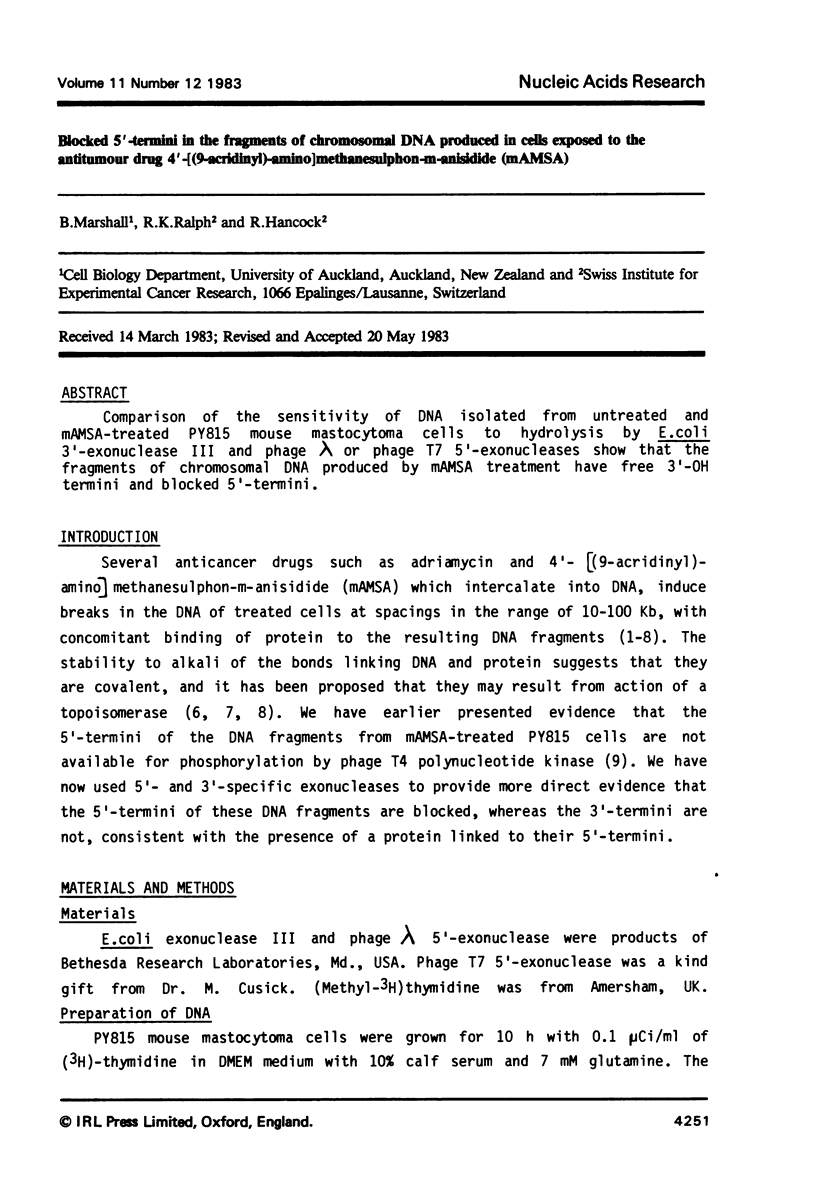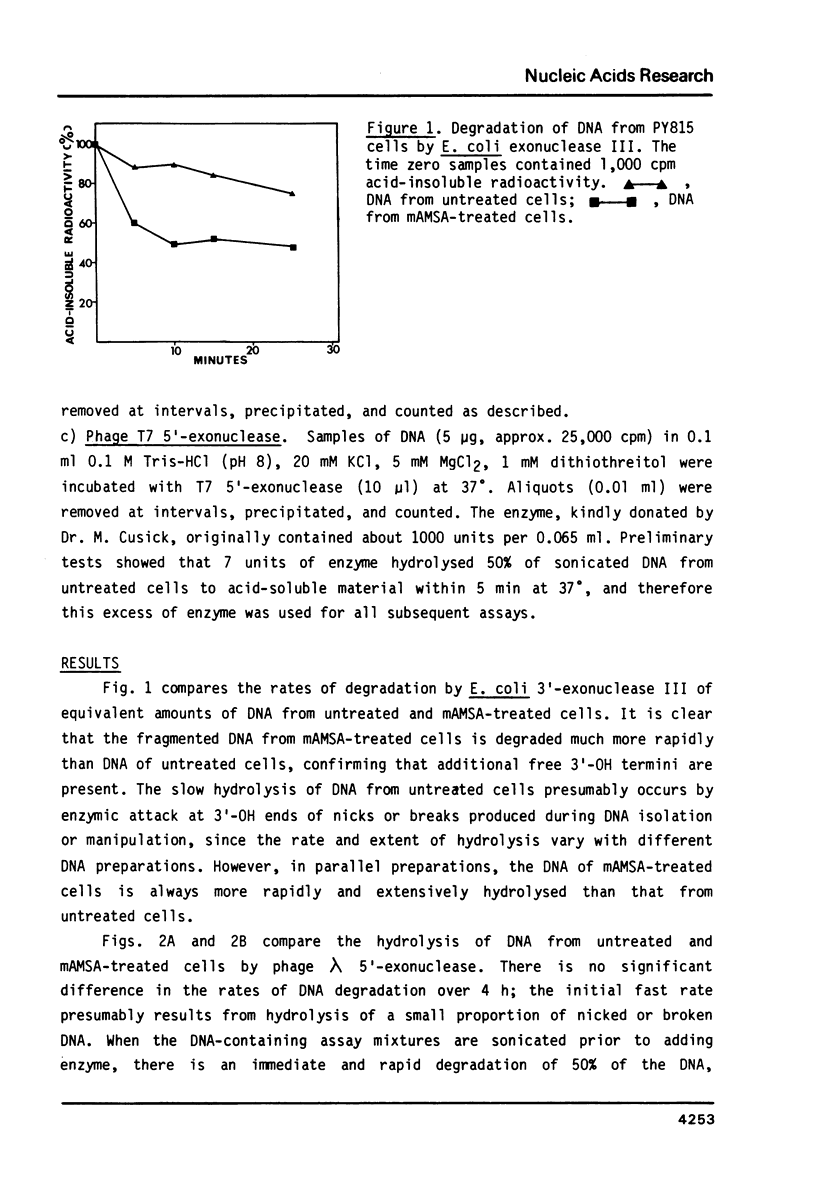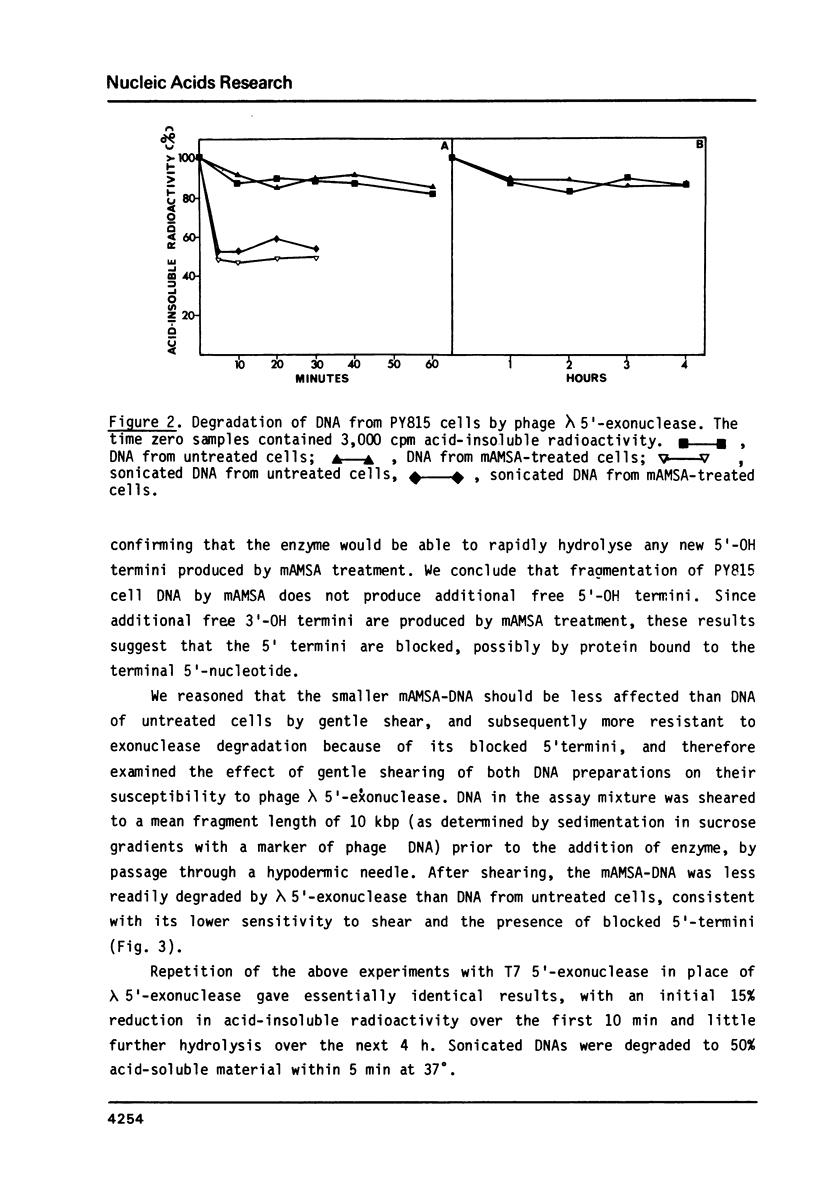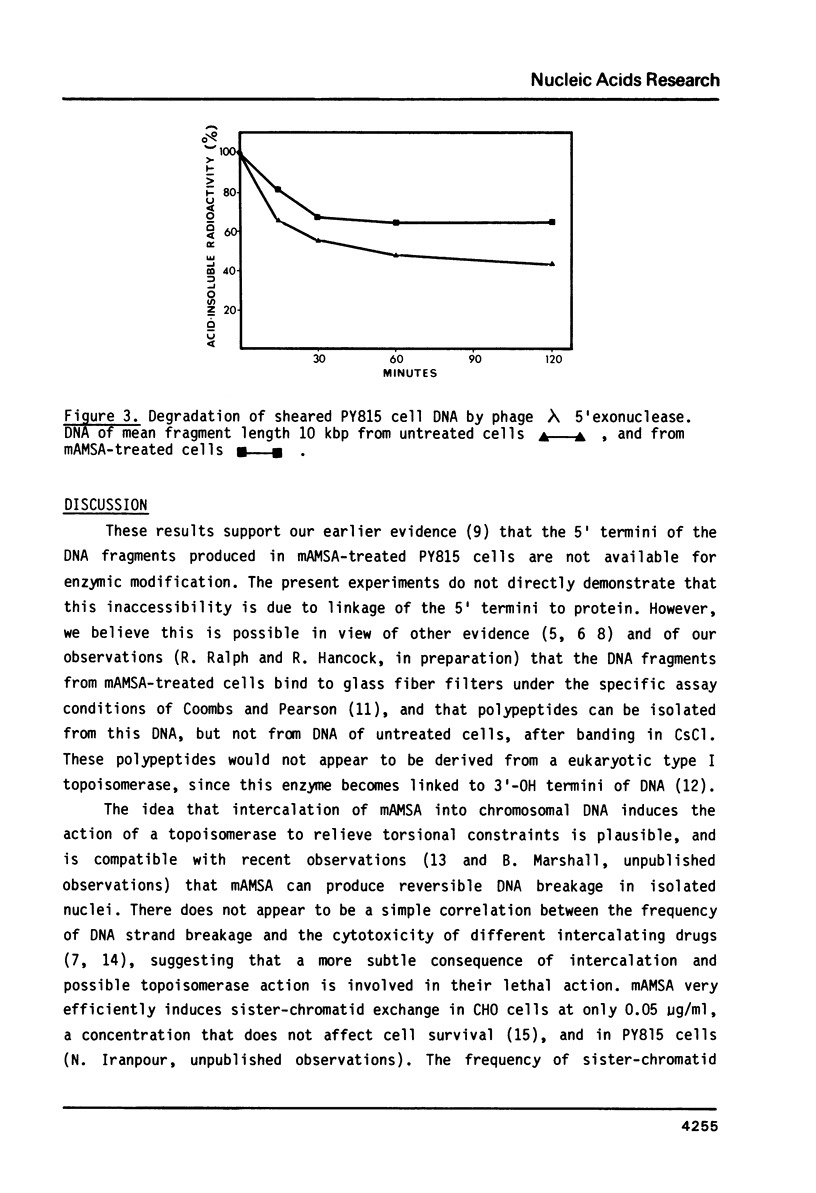Abstract
Comparison of the sensitivity of DNA isolated from untreated and mAMSA-treated PY815 mouse mastocytoma cells to hydrolysis by E.coli 3'-exonuclease III and phage lambda or phage T7 5'-exonucleases show that the fragments of chromosomal DNA produced by mAMSA treatment have free 3'-OH termini and blocked 5'-termini.
Full text
PDF





Selected References
These references are in PubMed. This may not be the complete list of references from this article.
- Coombs D. H., Pearson G. D. Filter-binding assay for covalent DNA-protein complexes: adenovirus DNA-terminal protein complex. Proc Natl Acad Sci U S A. 1978 Nov;75(11):5291–5295. doi: 10.1073/pnas.75.11.5291. [DOI] [PMC free article] [PubMed] [Google Scholar]
- Deaven L. L., Oka M. S., Tobey R. A. Cell-cycle-specific chromosome damage following treatment of cultured Chinese hamster cells with 4'-[(9-acridinyl)-amino]methanesulphon-m-anisidide-HCl. J Natl Cancer Inst. 1978 May;60(5):1155–1161. [PubMed] [Google Scholar]
- Furlong N. B., Sato J., Brown T., Chavez F., Hurlbert R. B. Induction of limited DNA damage by the antitumor agent Cain's acridine. Cancer Res. 1978 May;38(5):1329–1335. [PubMed] [Google Scholar]
- Gellert M. DNA topoisomerases. Annu Rev Biochem. 1981;50:879–910. doi: 10.1146/annurev.bi.50.070181.004311. [DOI] [PubMed] [Google Scholar]
- Ikeda H., Moriya K., Matsumoto T. In vitro study of illegitimate recombination: involvement of DNA gyrase. Cold Spring Harb Symp Quant Biol. 1981;45(Pt 1):399–408. doi: 10.1101/sqb.1981.045.01.054. [DOI] [PubMed] [Google Scholar]
- Krump-Konvalinkova V., van den Berg K. J. Leukaemia virus infection promotes fibroblast transformation by normal BALB/c mouse DNA. Nature. 1980 Sep 25;287(5780):353–354. doi: 10.1038/287353a0. [DOI] [PubMed] [Google Scholar]
- Marshall B., Ralph R. K. The nature of DNA breakage by 4'-[(9-acridinyl)amino]methane-sulphone-m-anisidide. FEBS Lett. 1982 Aug 23;145(2):187–190. doi: 10.1016/0014-5793(82)80164-6. [DOI] [PubMed] [Google Scholar]
- Morris S. M., Heflich R. H., Beranek D. T., Kodell R. L. Alkylation-induced sister-chromatid exchanges correlate with reduced cell survival, not mutations. Mutat Res. 1982 Sep;105(3):163–168. doi: 10.1016/0165-7992(82)90006-9. [DOI] [PubMed] [Google Scholar]
- Nash H. A., Mizuuchi K., Enquist L. W., Weisberg R. A. Strand exchange in lambda integrative recombination: genetics, biochemistry, and models. Cold Spring Harb Symp Quant Biol. 1981;45(Pt 1):417–428. doi: 10.1101/sqb.1981.045.01.056. [DOI] [PubMed] [Google Scholar]
- Pommier Y., Kerrigan D., Schwartz R., Zwelling L. A. The formation and resealing of intercalator-induced DNA strand breaks in isolated L1210 cell nuclei. Biochem Biophys Res Commun. 1982 Jul 30;107(2):576–583. doi: 10.1016/0006-291x(82)91530-3. [DOI] [PubMed] [Google Scholar]
- Ralph R. K. On the mechanism of action of 4'-[(9-acridinyl)-amino] methanesulphon-m-anisidide. Eur J Cancer. 1980 May;16(5):595–600. doi: 10.1016/0014-2964(80)90198-x. [DOI] [PubMed] [Google Scholar]
- Ross W. E., Bradley M. O. DNA double-stranded breaks in mammalian cells after exposure to intercalating agents. Biochim Biophys Acta. 1981 Jun 26;654(1):129–134. doi: 10.1016/0005-2787(81)90145-3. [DOI] [PubMed] [Google Scholar]
- Ross W. E., Glaubiger D. L., Kohn K. W. Protein-associated DNA breaks in cells treated with adriamycin or ellipticine. Biochim Biophys Acta. 1978 Jun 22;519(1):23–30. doi: 10.1016/0005-2787(78)90059-x. [DOI] [PubMed] [Google Scholar]
- Ross W. E., Glaubiger D., Kohn K. W. Qualitative and quantitative aspects of intercalator-induced DNA strand breaks. Biochim Biophys Acta. 1979 Mar 28;562(1):41–50. doi: 10.1016/0005-2787(79)90124-2. [DOI] [PubMed] [Google Scholar]
- Waring M. J. DNA modification and cancer. Annu Rev Biochem. 1981;50:159–192. doi: 10.1146/annurev.bi.50.070181.001111. [DOI] [PubMed] [Google Scholar]
- Zwelling L. A., Kerrigan D., Michaels S. Cytotoxicity and DNA strand breaks by 5-iminodaunorubicin in mouse leukemia L1210 cells: comparison with adriamycin and 4'-(9-acridinylamino)methanesulfon-m-anisidide. Cancer Res. 1982 Jul;42(7):2687–2691. [PubMed] [Google Scholar]
- Zwelling L. A., Michaels S., Erickson L. C., Ungerleider R. S., Nichols M., Kohn K. W. Protein-associated deoxyribonucleic acid strand breaks in L1210 cells treated with the deoxyribonucleic acid intercalating agents 4'-(9-acridinylamino) methanesulfon-m-anisidide and adriamycin. Biochemistry. 1981 Nov 10;20(23):6553–6563. doi: 10.1021/bi00526a006. [DOI] [PubMed] [Google Scholar]


